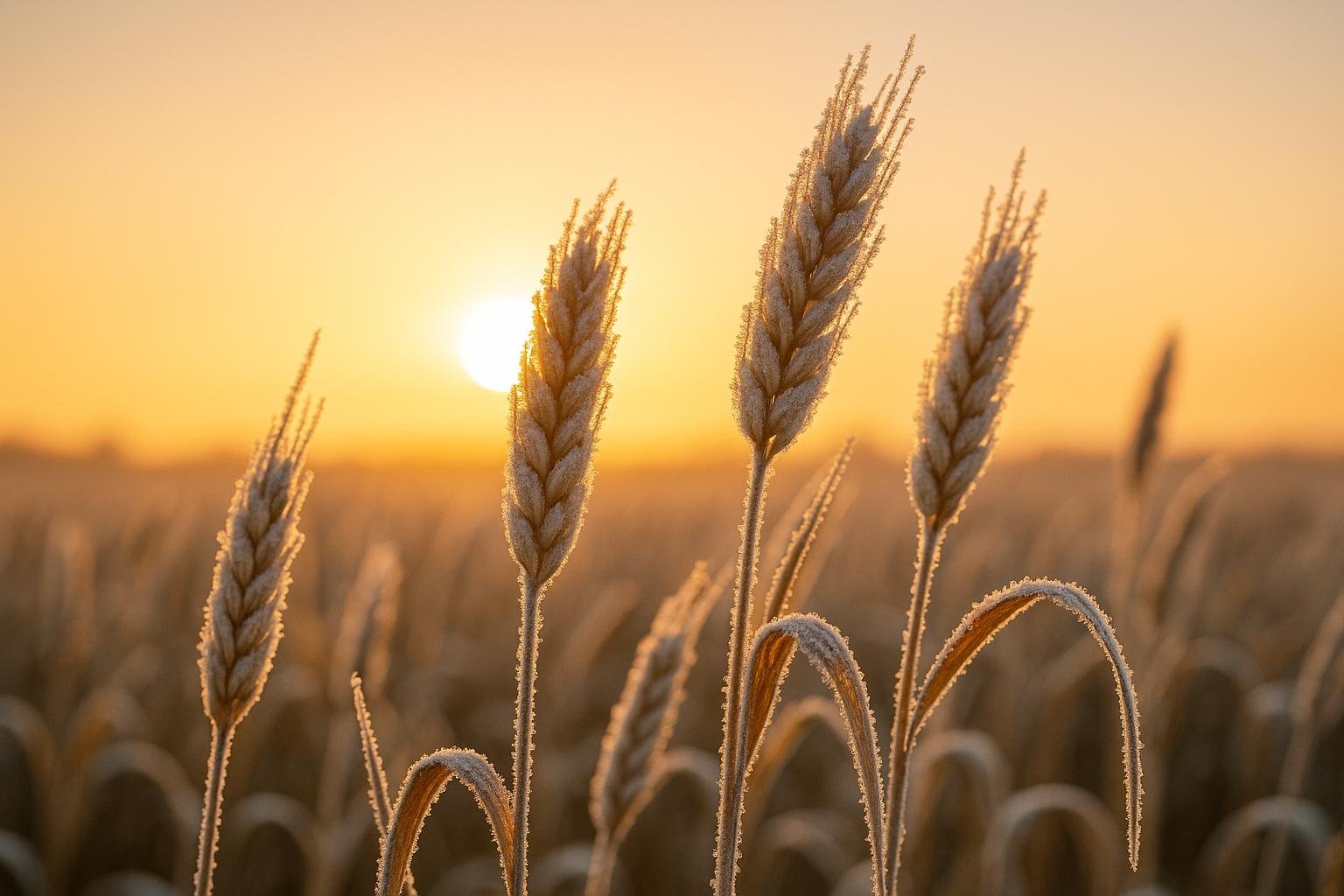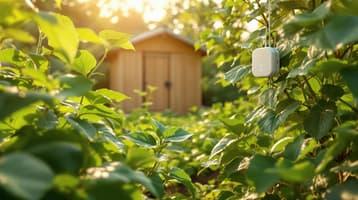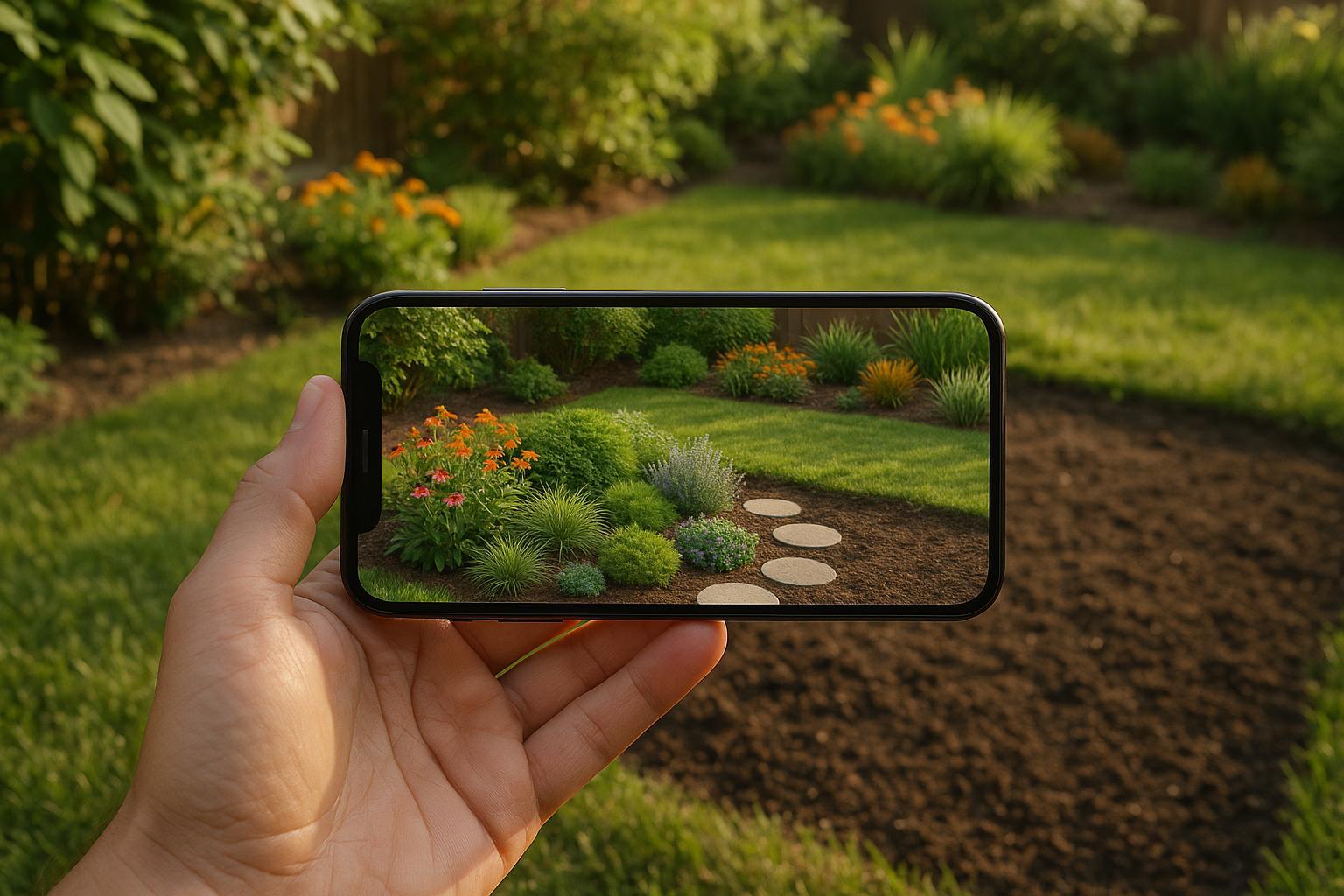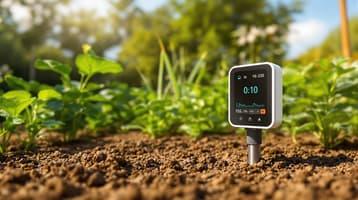AI Research on Frost-Resistant Crops

AI is helping farmers and gardeners grow frost-resistant crops faster and more efficiently. By analyzing data like genetics, weather, and soil conditions, AI tools identify plant traits that survive freezing temperatures while maintaining quality and yield. This technology isn’t just for large farms - home gardeners are also using AI tools like AIGardenPlanner to get personalized advice on frost-resistant plants, planting schedules, and protection strategies.
Key takeaways:
- AI speeds up the process of breeding frost-tolerant crops.
- Tools analyze local climate and soil to suggest plants suited for specific frost risks.
- Home gardeners benefit from AI-driven insights, such as frost alerts and planting timelines.
AI makes managing frost challenges easier, whether you're growing vegetables in your backyard or running a large farm.
11 Frost-Resistant Vegetables to Grow in Winter

How AI Develops Frost-Resistant Crops
AI is playing a transformative role in developing crops that can withstand frost, using advanced techniques to identify patterns that were previously hidden. By combining genetic analysis, environmental data, and predictive algorithms, researchers are creating plant varieties that endure freezing temperatures while maintaining strong yields.
Machine learning has become a game-changer in this process. By analyzing specific genetic markers, these systems can pinpoint traits linked to frost tolerance, dramatically speeding up what used to be a time-consuming breeding process.
Additionally, computer vision tools are helping refine this work by capturing subtle changes in plants exposed to cold. The data collected provides insights into how certain genetic factors enhance a plant's ability to resist frost, offering a clearer understanding of cold resilience.
AI Tools for Climate-Adapted Crop Breeding
AI tools are taking crop breeding to the next level, especially when it comes to adapting to harsh climates. Deep learning networks analyze genetic profiles alongside historical climate records to identify frost-resistant traits. This allows researchers to focus on the most promising candidates early in the breeding process.
Genomic selection algorithms are another powerful tool. These systems dig into DNA markers associated with frost tolerance, helping scientists zero in on the genetic foundations of cold-resistant plants.
Climate modeling AI adds another layer of precision by incorporating weather patterns, soil conditions, and seasonal temperature trends. This helps forecast frost events, giving researchers a better understanding of the challenges crops face in different regions.
Robotic phenotyping systems, equipped with advanced sensors and cameras, are also changing the game. These systems monitor plant health, stress responses, and growth in controlled environments. The detailed data they collect feeds back into AI models, sharpening breeding strategies for frost resistance.
Examples of Frost-Resistant Crop Advances
AI-driven methods have already shown remarkable results in enhancing frost tolerance in crops. By leveraging tools like machine learning and climate modeling, researchers have developed new plant varieties that thrive even during frost events. These breakthroughs are not just for large-scale agriculture - they also bring exciting possibilities for home gardeners looking for hardy, frost-resistant plants.
The potential of these innovations is enormous, paving the way for crops that can better withstand environmental challenges while offering robust options for both farmers and gardening enthusiasts. AI is helping bridge the gap between cutting-edge agricultural research and practical, everyday applications.
What AI Means for Home Gardening
Recent advancements in frost-resistant crops are now making their way into American home gardens, thanks to the integration of AI technology. This shift is revolutionizing how gardeners tackle frost-related challenges by offering solutions tailored to their specific needs. Instead of relying on one-size-fits-all planting guides or trial-and-error experimentation, gardeners can now use tools that analyze local frost risks with precision.
Gone are the days of guessing which plants can withstand sudden frosts. AI-powered systems evaluate USDA hardiness zones, local weather trends, and historical frost data to provide recommendations customized to each garden’s unique conditions. These tools also help gardeners pinpoint the best planting times, predict frost events, and prepare protection strategies well in advance. By factoring in elements like elevation, proximity to water, and urban heat effects, AI delivers insights that reflect the microclimates of individual neighborhoods.
But the benefits don’t stop at plant selection. This proactive approach minimizes plant loss and boosts success rates, especially for gardeners in frost-prone areas growing vegetables or perennials. These innovations promise to refine every gardening decision, making the process more efficient and rewarding.
Personalized Plant Recommendations with AI
AI tools take personalization to the next level, using detailed local data to suggest plants that thrive in specific frost conditions. These systems don’t just rely on general climate data; they incorporate real-time weather patterns and long-term trends to tailor their advice to your garden’s needs.
Take AIGardenPlanner, for example. This platform combines climate analysis with personalized recommendations, using its AI Plant Advisor to account for your USDA hardiness zone and microclimatic factors that influence frost risks. Whether you’re cultivating vegetables, herbs, or ornamental plants, the tool suggests frost-resistant varieties that align with your goals.
What’s even more impressive is how these systems learn over time. By analyzing regional growing patterns and success rates, they continually refine their recommendations. This ensures that gardeners in areas like the upper Midwest or mountainous regions receive advice specifically suited to their cold-weather challenges, rather than generic tips that might not work in their environment.
Timing is another critical factor AI addresses. These platforms analyze historical frost dates, current weather forecasts, and plant growth timelines to recommend varieties that will mature before frost typically sets in. For vegetable gardeners, this means maximizing the growing season while reducing the risk of frost damage - an invaluable tool for anyone looking to get the most out of their garden.
Simplified Seasonal Planning for Gardeners
AI doesn’t just help with plant selection; it also simplifies the entire gardening calendar. Traditional planning required a deep understanding of climate patterns and growth cycles, but now AI handles these complexities, offering gardeners clear planting schedules and frost protection strategies.
By examining decades of historical weather data, these systems identify ideal planting windows for frost-sensitive crops. They calculate average last frost dates, account for seasonal temperature shifts, and create customized calendars. Gardeners receive specific timelines for starting seeds indoors, transplanting outdoors, and implementing frost protection measures.
Another game-changer is predictive frost alerts. AI systems monitor weather forecasts and soil temperatures to warn gardeners of potential frost events, giving them time to protect vulnerable plants. Whether that means covering tender crops, harvesting early, or moving containers indoors, these alerts can make all the difference during unpredictable spring and fall weather.
AI also supports succession planting strategies, helping gardeners stagger their planting intervals for continuous harvests while avoiding frost risks. By calculating optimal planting times, these tools ensure crops mature before frost sets in, providing a steady supply of produce throughout the season.
Finally, AI-driven seasonal planning includes advice on irrigation and soil management. These systems recommend watering schedules and soil preparation techniques that enhance plants’ natural resistance to cold. Healthy, well-hydrated plants with strong root systems are better equipped to handle frost, and AI tools help gardeners maintain these ideal growing conditions with ease.
🚀 Ready to Reinvent Your Garden?
Join thousands of homeowners who have transformed their gardens using our AI design tool. Upload one photo to explore endless possibilities.
Get your AI garden designs →Standard vs. AI-Driven Frost-Resistant Gardening Methods
When it comes to frost protection in gardening, comparing traditional methods with AI-driven approaches highlights a world of difference. While traditional methods rely on general guidance passed down through generations, AI tools offer precise, real-time updates tailored to specific conditions.
For years, traditional gardening methods have been the backbone of frost protection. These approaches often draw from almanacs, USDA hardiness zone maps, and local wisdom, offering advice like "plant after the last frost date" or "cover plants when temperatures fall below 32°F." While these strategies have stood the test of time, they often fall short in addressing today’s unpredictable weather patterns. Gardeners using these methods must rely on their own knowledge, constantly monitoring forecasts and making educated guesses. This works for seasoned gardeners who understand their local climate, but it can feel overwhelming for beginners or those gardening in unfamiliar areas.
On the other hand, AI-driven frost protection takes a completely different route. These systems analyze massive amounts of data to deliver hyper-localized recommendations. By processing decades of climate data, AI tools provide advice that’s not only accurate but also tailored to specific locations. This is especially useful when dealing with sudden weather changes or gardening in a new environment.
Another key difference lies in adaptability. Traditional methods often rely on historical averages, which may no longer align with current climate realities. AI tools, however, continuously update their recommendations based on the latest data, ensuring they stay relevant even as weather patterns shift unpredictably.
Benefits and Challenges of AI Tools
AI-driven gardening tools bring a host of advantages that go beyond convenience. For starters, these systems excel at pattern recognition, uncovering connections between weather, soil conditions, and plant performance that might take years for a human gardener to notice. They can process dozens of variables at once - something traditional methods simply can’t match.
One standout benefit is precision timing. AI tools can pinpoint the best planting days, factoring in seed germination times, growth rates, and frost patterns. This level of detail helps maximize growing seasons while reducing risks.
However, AI tools aren’t without their challenges. The technology barrier can be intimidating for gardeners who prefer a hands-on approach. Some worry that relying too much on AI might take away the joy of observing and working with nature. Additionally, data dependency can be a limitation. AI systems are only as accurate as the data they’re trained on, and gaps in local weather information or unique microclimates can sometimes lead to less-than-perfect recommendations.
| Aspect | Traditional Methods | AI-Driven Methods |
|---|---|---|
| Speed | Days to weeks of research | Minutes for detailed analysis |
| Precision | General seasonal guidelines | Exact, day-specific advice |
| Adaptability | Based on historical averages | Continuously updated data |
| Learning Curve | Years of experience needed | Instant expert-level insights |
| Cost | Low (books, almanacs) | Moderate (subscriptions) |
| Weather Response | Reactive (after the fact) | Proactive (predictive) |
Cost is another area where these methods differ. Traditional approaches require little more than reference materials and basic weather tools. In contrast, AI platforms like AIGardenPlanner offer subscription models, with plans starting at around $9 per month when billed annually. These subscriptions provide access to professional-grade insights that can significantly simplify garden management.
AI tools also shine in integration capabilities. They can manage multiple aspects of gardening - plant selection, timing, irrigation, and even pest control - all in one system. Traditional methods, on the other hand, often require gardeners to handle these tasks separately, increasing the risk of overlooking important details.
sbb-itb-4d6a8dd
Future Directions and Challenges in AI-Driven Gardening
AI-driven gardening is advancing at an impressive pace, but it’s not without its obstacles. Current systems can already analyze weather patterns and suggest frost-resistant plant varieties. Researchers are now pushing the boundaries by integrating satellite imagery and sensor networks to deliver hyper-local insights. These innovations could revolutionize how we approach gardening, but there are still hurdles to clear.
One major challenge is data quality. In areas where weather stations are sparse, gaps in microclimate data make it harder for AI systems to provide accurate recommendations. Another issue is the computational power required for advanced AI models, which can drive up operational costs. While cloud-based processing has made these tools more accessible, the expense may still deter casual gardeners from adopting them.
These challenges highlight the need for improvements that could reshape both commercial agriculture and home gardening.
Expanding Access to AI Gardening Tools
Bringing AI gardening tools to the average user means simplifying the technology and making it more affordable. Right now, many advanced systems are tailored to large-scale agricultural operations, with interfaces and pricing structures that can feel out of reach for home gardeners. The real challenge is balancing simplicity and cost without sacrificing the technology’s capabilities.
Tools like AIGardenPlanner are a step in the right direction. By offering affordable plans and features such as turning garden photos into detailed landscape designs, they lower the technical barriers that might otherwise discourage users. These kinds of innovations make it easier for anyone to experiment with AI-driven gardening.
However, education remains a sticking point. For gardeners unfamiliar with modern tech, digital solutions can seem overwhelming. To address this, platforms are investing in easy-to-follow tutorials, responsive customer support, and intuitive designs that make the tools feel approachable.
Mobile technology is also making AI gardening more accessible. Smartphone apps now allow users to snap a photo of their garden, identify plants, and even receive frost warnings. This kind of on-the-go functionality means gardeners don’t need to spend hours learning complicated software - they can get actionable insights right from their pockets.
Cost remains a concern, though. While subscription models are generally more affordable than traditional software licenses, recurring fees can add up. Some platforms are experimenting with freemium models, offering basic features for free and charging for advanced tools. This approach lets users try out AI gardening without committing to a subscription, making the technology more appealing to a broader audience.
These efforts to make AI tools more accessible are helping bridge the gap between advanced technology and everyday gardening.
Addressing Regional Climate Differences
Another critical area for AI gardening tools is adapting to the diverse climates across the United States. From Florida’s humid subtropics to the chilly northern states, the country’s wide range of climate zones presents unique challenges for providing localized gardening advice.
Improving data quality is key to overcoming these challenges. IoT sensors and hyper-local weather data can help capture microclimate variations that traditional weather stations often miss. For example, neighborhoods near the Great Lakes experience lake-effect weather patterns that can drastically affect frost conditions. AI systems relying solely on regional averages might miss these nuances, leading to less accurate recommendations. By incorporating factors like topography, proximity to water, and urban heat islands, AI tools can offer more tailored advice.
Seasonal timing is another variable that AI systems must account for. In warmer regions, gardeners might plant frost-sensitive crops weeks earlier than those in colder areas. Platforms need algorithms that not only analyze current weather conditions but also consider historical climate data specific to each location.
Regional gardening traditions and preferences also play a role. Gardeners in the Southwest, for instance, often focus on drought-resistant plants and water conservation, while those in the Pacific Northwest may prioritize managing moisture. For AI tools to resonate with users, they need to reflect these local priorities alongside scientific insights.
Conclusion: Using AI for a Frost-Resilient Garden
AI is reshaping the way we approach frost-resistant gardening, blending cutting-edge agricultural science with practical solutions for home gardeners. What was once a tool reserved for large-scale farming is now available to gardeners across the U.S., making advanced techniques accessible to everyone.
These AI systems dive deep into your garden’s unique conditions - analyzing everything from your local climate to microclimate quirks - to recommend frost-resistant plants that thrive in your environment. Gone are the days of relying on generic advice that doesn’t account for specific local challenges.
Take AIGardenPlanner, for example. This tool transforms simple garden photos into professional landscape designs while offering tailored recommendations based on your location and climate. Similarly, the AI Plant Advisor evaluates your garden’s unique conditions to suggest frost-resistant varieties that align with your needs. By integrating these advanced tools, gardeners can now address challenges posed by unpredictable weather with precision.
As climate patterns grow more erratic, these AI tools step in where traditional guides fall short. Whether you’re dealing with the lake-effect snow of the Great Lakes or the varied microclimates of California, AI processes vast amounts of localized weather data to provide insights that feel almost tailor-made.
What’s particularly impressive is how these tools adapt to regional differences. A gardener in Minnesota bracing for brutal winters gets advice suited to those extremes, while someone in Georgia with milder conditions receives recommendations that reflect their climate. This level of precision and customization was once unthinkable but is now within reach thanks to AI.
As this technology evolves, it’s becoming more affordable and accessible, opening the door for gardeners of all skill levels. Whether you’re protecting your first vegetable patch or extending the growing season in a seasoned garden, AI is making it easier to create thriving, frost-resilient spaces that can handle whatever the weather throws your way.
FAQs
How is AI making it easier to develop frost-resistant crops compared to traditional methods?
🎨 Visualize Your Dream Garden Today!
Transform any outdoor space into a professional landscape design in minutes. Just upload a photo, choose your style, and let our AI do the rest.
Start your garden transformation now →How AI is Shaping Frost-Resistant Crops
AI is transforming the way frost-resistant crops are developed, offering a faster and more precise alternative to traditional methods like hybridization or selective breeding. By leveraging advanced algorithms, AI can sift through massive amounts of genetic data to pinpoint traits that help plants endure cold temperatures. It can even forecast how these plants will perform under frosty conditions.
This approach drastically shortens the time needed to cultivate resilient crops and enhances the accuracy of selecting the most effective genetic traits. The outcome? Tougher plants that thrive in colder climates, benefiting not just large-scale farmers but also home gardeners aiming to grow in less-than-ideal environments.
What challenges might arise when using AI tools like AIGardenPlanner for home gardening?
Challenges of Using AI Tools in Gardening
AI tools like AIGardenPlanner can make home gardening more manageable, but they’re not without their limitations. One common issue is that AI often provides broad advice, which might not fully align with the unique conditions in your garden. Factors like specific soil composition, microclimates, and unexpected weather patterns can sometimes fall outside the scope of AI recommendations.
Another challenge is that these tools may struggle to account for local variations, which can affect the success of garden designs or plant suggestions. For instance, a plant that thrives in one region might not do as well in another, even if the AI suggests otherwise.
There’s also the environmental angle to consider. AI systems often require significant energy for processing, which might be a concern for gardeners who prioritize eco-friendly practices.
To make the most of AI tools, try combining their insights with your own gardening experience and advice from local experts. This blend of technology and hands-on knowledge can help you create a garden that truly thrives.
How does AI adapt its recommendations for different climates and microclimates across the United States?
AI fine-tunes its recommendations by examining localized factors like weather trends, soil quality, and temperature changes. This allows it to suggest strategies that suit specific climates and microclimates. For example, frost-resistant crop recommendations are tailored to work effectively in a wide range of environments, from humid coastal regions to dry, arid landscapes.
By taking into account elements such as humidity levels, soil moisture, and seasonal temperature patterns, AI provides gardeners with highly customized advice. These insights help you select the right plants and care methods for your unique location. Whether you're managing a small backyard garden or tackling a larger plot in a tough climate, this level of precision can lead to better outcomes.
Related posts
Related Articles

Revolutionize Your Gardening Experience with the AI Garden App
Discover the world of AI-powered gardening with the AI Garden App. Learn about its features, benefits, and how to choose the right AI Garden App for your needs.

IoT Security for Garden Sensors: Key Features
Learn how to secure your IoT garden sensors with encryption, access controls, and network protection to safeguard your garden's data.

Low Voltage Lighting vs. Solar Lighting
Explore the pros and cons of low voltage versus solar lighting for your garden, including costs, performance, and best uses.

How AR Previews Transform Garden Planning
Explore how Augmented Reality is revolutionizing garden planning with real-time visuals, precise measurements, and personalized plant guidance.

Ultimate Guide to AI-Powered Soil Monitoring
Learn how AI-powered soil monitoring transforms gardening with real-time insights for healthier soil and more efficient resource use.

Ultimate Guide to Seasonal Plant Selection
Learn how to select seasonal plants for your garden based on climate, soil, and light conditions with AI tools for tailored recommendations.